What is a Gram Stain?
 Karyn Maier
Karyn Maier
A Gram stain refers to a positive or negative test result produced when an iodine wash is introduced to a culture of bacteria in order to identify its species. This test, known as Gram staining, works by detecting the presence of lipopolysaccharides (lipoglycans) and peptidoglycans (mureins) contained within the cell walls of the bacteria sample. Bacteria that have a high level of peptidoglycans are said to be Gram-positive. In contrast, lower levels of peptidoglycans with lipopolysaccharides indicate that the sample is Gram-negative.
First, the bacteria sample is placed on a glass slide and heated only to the point of rendering it innocuous in terms of being infectious to the handler. Next, the bacteria sample is treated with a gentian violet-iodine solution for up to sixty seconds. The slide is then gently rinsed under clean water and the Gram solution is applied, which is a mixture of iodine and potassium iodide diluted in water. This step triggers a reaction to the gentian violet compound.

Initially, the reaction produces a dark blue color. However, a subsequent rinse with ethyl alcohol leads to the color in some bacteria samples to bleed out, but not in others. A final dye solution is applied that uses a contrasting color, usually a variation of red. A sample that accepts this counterstain will appear pink, and is designated as Gram-negative. However, a sample that retains the dark blue color is Gram-positive.

Aside from identification purposes, the significance of the Gram stain test lies in the fact that Gram-negative bacteria produce potent endotoxins that can cause serious diseases, such as cholera and typhoid. Many Gram-negative bacteria are also resistant to antibiotics and it is not possible to manufacture vaccines from them. In addition, not all bacteria produce a positive or negative result. In fact, some species are considered Gram indeterminate or Gram variable. Other species are entirely unaffected by the test simply due to having a wax-like protective layer in their cell walls that the stains cannot permeate.

The Gram stain test was developed in the late 1800s by the noted Danish bacteriologist, Hans Christian Gram. However, the original purpose of the Gram stain test was not to distinguish between different bacterial species at all. In fact, Dr. Gram merely set out to devise a better way to detect the presence of bacteria in sputum samples provided by pneumonia patients. It is also interesting to note that Dr. Gram’s discovery, while unintentional, would have a big impact on the study of antibiotic-resistant bacteria half a century later.
AS FEATURED ON:
AS FEATURED ON:














Discussion Comments
@giddion – That's the same bacteria that causes strep throat, right? I have had that before, and it is pretty serious, too.
My throat swelled so much that I could barely swallow saliva, and I was running a fever of 100 degrees. My doctor stuck a giant cotton swab into the back of my throat to gather a sample of the bacteria.
She told me that the result was positive, and at the time, I didn't know that meant Gram-positive. All I knew was that it meant I did have strep throat.
It is a pretty tough illness, so my doctor gave me a steroid shot and a steroid dose pack, along with some antibiotics. The steroids were so powerful that I felt nearly healed within a day.
Streptococcus gram stains are positive, and they can cause conditions that are pretty serious. I guess a bacteria doesn't have to be Gram-negative in order to make you very sick.
I've heard that streptococcus bacteria can cause pneumonia and bronchitis. Since my grandmother died of pneumonia, I know how serious this condition can be, especially for the elderly.
The doctor began treating her with antibiotics, but her condition was too intense. We had hoped that because she had been hospitalized, she would survive. Even doctors can't reverse some conditions, though, and she succumbed to the fluid in her lungs.
@OeKc05 – You are right. Not all bacteria producing Gram-negative stains are untreatable with antibiotics. Fortunately, both typhoid fever and cholera can be treated with them.
I have two cousins who do a lot of missionary work in developing countries, and they have to be vaccinated for typhoid fever before going over there. The United States doesn't have a cholera vaccine, but since you can take antibiotics for it if you fall ill with it, you aren't likely to die from it.
Both typhoid fever and cholera make you have watery diarrhea and dehydrate rapidly. My cousins have seen many people in Africa and South America with these diseases, and they have to be hooked up to IV's and have fluids delivered to their bodies.
I had no idea before reading this article that any bacteria could be resistant to antibiotics. I thought that only viruses could not be treated with antibiotics.
It's scary to think that the bacteria that produce a negative gram stain are also the most dangerous, since they are the ones that can't be knocked out with pills. It's even worse that vaccines cannot be made from them.
So, do cholera and typhoid fever fall into the category of illnesses that won't respond to antibiotics and have no vaccines? I see that they are Gram-negative, but not all of these resist antibiotics, I'm sure.
Post your comments